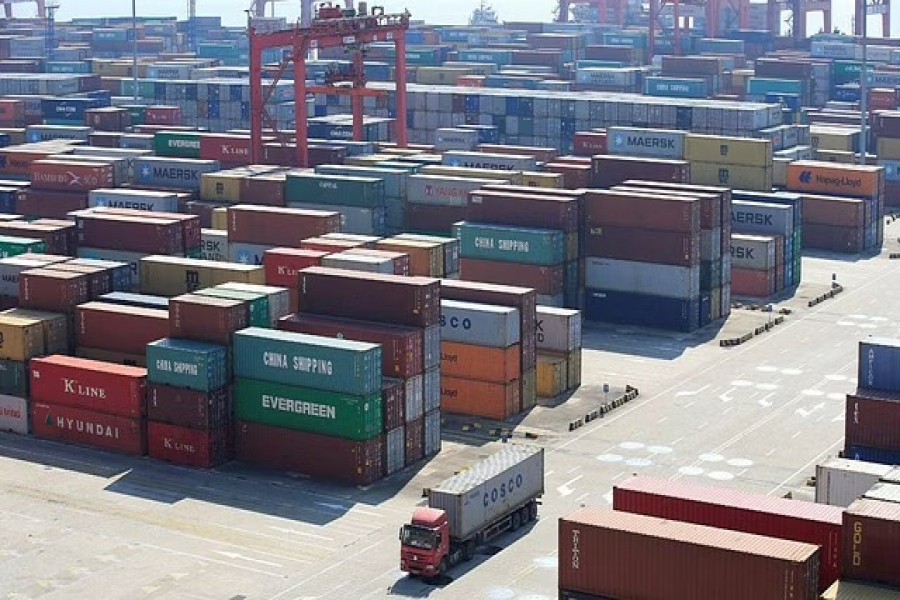China's export growth unexpectedly picked up speed in July, offering an encouraging boost to the economy as its struggles to recover from a COVID-induced slump, but weakening global demand could start to drag on shipments in coming months, Reuters reports.
Exports grew 18.0 per cent in July from a year earlier, the fastest pace this year, official customs data showed on Sunday, compared with a 17.9 per cent rise in June and beating analysts' expectations for a 15.0 per cent gain.
Exports have been one of the few bright spots for the Chinese economy in 2022, as widespread lockdowns hit businesses and consumers hard and the once mighty property market lurches from crisis to crisis.
"China's export growth surprised again on the upside. (It) continues to help China's economy in a difficult year as domestic demand remains sluggish," said Zhiwei Zhang, chief economist at Pinpoint Asset Management.
However, many analysts have expected shipments to fade amid cooling global consumption.
A global factory survey released last week showed demand weakened in July, with orders and output indexes falling to their weakest levels since the onset of the COVID-19 pandemic in early 2020.
China's official manufacturing survey indicated activity contracted last month, raising fears that the economy's recovery from lockdowns in spring will be slower and bumpier than expected.
But there were signs that transport and supply chain disruptions caused by COVID restrictions were continuing to ease, just in time for shippers preparing for peak year-end shopping demand.
Foreign trade container throughput at eight major Chinese ports rose 14.5 per cent in July, speeding up from the 8.4 per cent gain in June, according to data released by the domestic port association.
Container throughput at COVID-hit Shanghai port hit a record high in July.
July exports may also have been buoyed by pent-up demand from Southeast Asia as supply snarls eased and factories there ramped up production, Bruce Pang, chief economist and head of research at Jones Lang Lasalle Inc, said in a research note.
Moreover, amid surging inflation, some European and US customers may have frontloaded orders heading into the holiday season to ensure they had goods on hand, he added.
Still, while export growth remained high, mainly backed by price factors, the volume of exported goods dropped in July, said Chang Ran, a senior analyst at Zhixin Investment Research Institute.
"Looking ahead in the second half of the year, exports are expected to be resilient in the short run, but weakening external demand may pressure them in the fourth quarter," Chang said.
IMPORTS STILL TEPID
After a shaky second quarter, most analysts have expected China's import momentum to pick up modestly in the latter half of the year, supported by construction-related equipment and commodities as the government ramps up infrastructure spending.
But imports last month were again weaker than expected, suggesting domestic demand remains soft.
Imports rose 2.3 per cent from a year earlier, compared with June's 1 per cent gain and missing a forecast of a 3.7 per cent rise.
"Despite an uptick in domestic demand amid loosening COVID control measures, the weak performance of the production side dragged on imports," said Xu Shuzheng, a researcher at CITIC Securities, adding that fresh COVID flare-ups could hinder the economy's recovery.
Crude oil imports in July fell 9.5 per cent from a year earlier as fuel demand recovered more slowly than expected due to virus outbreaks.
The volume of imported integrated circuits - a major Chinese import - also dropped 19.6 per cent in July from a year earlier, according to Reuters' calculations.
That may be an additional red flag for exports, as a significant amount of the country's imports are components for goods that are then re-exported.
China posted a record $101.26 billion trade surplus last month, well above the $90.0 billion surplus analysts had expected.
The country's top economic planner said last week that the economy is in the "critical window" of stabilisation and recovery, and the third quarter is "vital."
Top leaders recently signalled they were prepared to miss the government growth target of around 5.5 per cent for 2022, which analysts said had been looking increasingly unattainable after the economy narrowly avoided contracting in the second quarter.
The International Monetary Fund in late July sharply cut its 2022 growth forecast for China to 3.3 per cent from 4.4 per cent in April, citing COVID lockdowns and the worsening crisis in the country's property sector.


